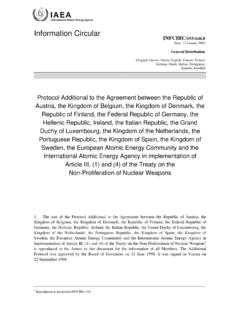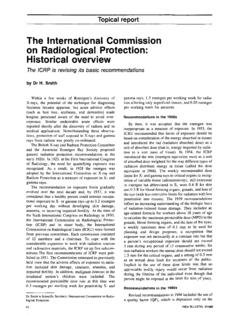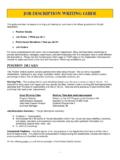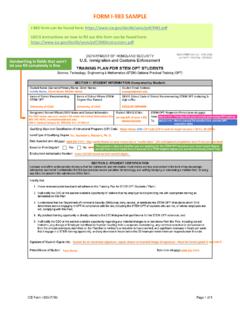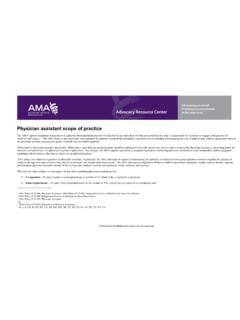Transcription of The Competency Framework - International Atomic Energy …
1 The Competency Framework @A guide for IAEA managers and staff1 INTRODUCTION..31. CORE VALUES ..82. CORE COMPETENCIES .. 10 COMMUNICATION .. 11 TEAMWORK .. 12 PLANNING AND ORGANIZING .. 13 ACHIEVING RESULTS .. 143. FUNCTIONAL COMPETENCIES.. 15 LEADING AND SUPERVISING .. 16 ANALYTICAL THINKING .. 17 KNOWLEDGE SHARING AND LEARNING .. 18 JUDGEMENT/DECISION MAKING .. 19 TECHNICAL/SCIENTIFIC CREDIBILITY .. 20 CHANGE MANAGEMENT .. 21 COMMITMENT TO CONTINUOUS PROCESS IMPROVEMENT .. 22 PARTNERSHIP BUILDING .. 23 CLIENT ORIENTATION .. 24 PERSUASION AND INFLUENCING .. 25 RESILIENCE .. 26 CONTENT3 What is a Competency Framework ? A Competency Framework is a model that broadly describes performance excellence within an organization.
2 Such a Framework usually includes a number of competencies that are applied to multiple occupational roles within the organization. Each Competency defi nes, in generic terms, excellence in working behaviour; this defi nition then establishes the benchmark against which staff are assessed. A Competency Framework is a means by which organizations communicate which behaviours are required, valued, recognized and rewarded with respect to specifi c occupational roles. It ensures that staff, in general, have a common understanding of the organization s values and expected excellent performance frameworks are used throughout the United Nations system, as well as in many government and private sector organizations.
3 What are the components of the Framework ?The Agency s Competency Framework includes core values, and core and functional competencies. The defi nitions of these components are as follows:Core values are principles that infl uence people s actions and the choices they make. They are ethical standards that are based on the standards of conduct for the International civil service and are to be upheld by all competencies provide the foundation of the Framework , describing behaviours to be displayed by all staff members. They are defi ned by occupational roles for a given competencies are defi ned by duties and responsibilities assumed by staff members for a given job. Based on the job complexity and level of responsibility, and the seniority of the occupational role, an average of three to fi ve functional competencies are assigned to a given the varied nature of its work, the Agency could adopt numerous core and functional competencies; however, following a thorough analysis of all scientifi c and administrative fi elds of work, it was decided to restrict the INTRODUCTION4number to four core competencies and eleven functional competencies.
4 The results of this analysis revealed that many competencies are shared across many positions and that a more standardized approach would ensure more effective and effi cient human resources management. The Competency Framework consists of three occupational roles for the core competencies and four occupational roles for the functional competencies. These roles refer to the primary purpose of and the relationship between jobs. For the core competencies, the occupational roles are broadly defi ned as follows: The Individual Contributor a staff member, normally without supervisory responsibility, who is accountable for his/her individual performance and contribution to the outputs of the team.
5 The Manager a staff member at the middle or senior professional level (at the P4 or P5 level) with managerial responsibility for human and/or fi nancial resources who oversees the delivery of programmatic results. These functions normally include Section Head, Unit Head and Team Leader. The Senior Manager a staff member at the Director or DDG, level who is responsible for creating an enabling environment and takes decisions impacting the entire programme/functional the functional competencies, the occupational roles are broadly defi ned as follows: Individual Contributor staff members, normally without supervisory responsibility, who are accountable for their individual performance and contribution to the outputs of their team.
6 Associate a junior or mid-level General Service (GS) staff member (at the G1 to G5 level) or junior professional (at the P1 or P2 level), who provides support to colleagues and works under the technical guidance of the supervisor. Specialist a senior General Service (GS) staff member (at the G6 or G7 level) or middle or senior level professional specialist (at the P3 to P5 level) who has expert knowledge in his/her fi eld of specialization and works independently. A Specialist does not normally have direct supervisory responsibility for staff members; however, he/she may assume project management responsibilities, including the coordination of human and/or fi nancial resources.
7 Manager a staff member at the Middle or Senior Professional level (at the P4 or P5 level) with managerial responsibility for human and fi nancial resources who oversees the delivery of programmatic results. These functions normally include: Section Head, Unit Head, Team Leader and Technical Senior Manager a staff member at the Director or DDG level who is responsible for creating an enabling environment and takes decisions impacting the entire programme / functional are competencies?A Competency is generally defi ned as a combination of skills , knowledge, attributes and behaviours that enables an individual to perform a task or an activity successfully within a given job.
8 Competencies are observable behaviours that can be measured and evaluated, and thus are essential in terms of defi ning job requirements and recruiting, retaining and developing staff. Why use competencies?Competencies enable the staff of an organization to have a clear understanding of the behaviours to be exhibited and the levels of performance expected in order to achieve organizational results. They provide the individual with an indication of the behaviours and actions that will be valued, recognized and a Competency Framework enables an organization to successfully align its staff s skills , capabilities and knowledge with organizational priorities, resulting in business improvement and effi , a well structured and well defi ned Competency Framework plays a key role in accomplishing an organization s goals in line with its mission and mandate.
9 More specifi cally, competencies ensure that: Clear expectations are set and staff members are guided as to how they can assume and reinforce behaviours in line with the organization s mission, culture and goals. A shared language is created to describe what is needed and expected in the work environment, thereby providing for reliable and high quality performance delivery. The various facets of human resources management can be integrated, enhancing consistency in human resources planning, recruitment, learning and development, and performance management, and thereby contributing to the streamlining of human resources operations and ultimately to effi ciency gains. skills gaps are addressed, strengths are further developed and requirements for career progression are clarifi ed.
10 Staff mobility, organizational change and shaping of the organizational culture are are the competencies being used and supported?Competencies are widely used across the Agency and are embedded in all human resources management functions, such as planning, recruitment, performance management and staff development. They are determined by the occupational roles and responsibilities, and the complexity of duties outlined in job descriptions. For planning, competencies are applied in job design, which involves the determination of the job content, the requirements to carry out the job and the relationships between the job holder and other staff. In this context, competencies ensure that the attributes, skills and behaviours necessary to achieve the highest performance standards for a given job are specifi ed.


